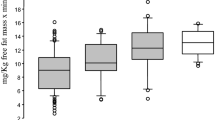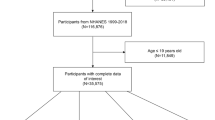Abstract
Objective: This study aims to identify the lifestyle determinants of insulin-like growth factor-I (IGF-I) and its main binding proteins (IGFBPs), C-peptide, and sex hormone-binding globulin (SHBG) to help elucidate the mechanism through which lifestyle factors may affect cancer risk. Methods: This study is based on a sample of 292 British women, aged 20–70 years, whose lifestyle characteristics were assessed using a self-administered questionnaire and whose serum hormone concentrations were measured using immunoassays. Results: Age was a strong determinant of both IGF-I and IGFBP levels; women aged 65–70 years had significantly lower IGF-I and IGFBP-3 concentrations and significantly higher IGFBP-1 and IGFBP-2 concentrations than women aged 20–24 years. Body mass index (BMI) was not strongly associated with IGF-I, although women with a BMI of 26–27.9 kg/m2 had a higher IGF-I concentration compared with both lean (BMI <20 kg/m2) and obese (BMI 30+ kg/m2) women. However, obese women had a significantly higher C-peptide and IGFBP-3 concentration and a significantly lower IGFBP-1, IGFBP-2, and SHBG concentration compared with lean women. Increasing vigorous exercise was associated with a significantly lower C-peptide concentration and increasing leisure-time activity was associated with a significantly higher IGFBP-1 concentration. Other lifestyle factors such as job activity, smoking, and reproductive factors were not associated with any hormone. Conclusions: Our data show that age is a major determinant of both IGF-I and its main binding proteins in women. BMI has strong effects on IGFBPs, C-peptide, and SHBG, but its effects on IGF-I remain unclear. The possible effect of physical activity on IGFBP-1 requires further investigation.
Similar content being viewed by others
References
Pollak M (2000) Insulin-like growth factor physiology and cancer risk. Eur J Cancer 36: 1224-1228.
Hankinson SE,Willett WC,Colditz GA, et al. (1998) Circulating concentrations of insulin-like growth factor-I and risk of breast cancer. Lancet 351: 1393-1396.
Toniolo P,Bruning PF,Akhmedkhanov A, et al. (2000) Serum insulin-like growth factor-I and breast cancer. Int J Cancer 88: 828-832.
Giovannucci E,Pollak MN,Platz EA, et al. (2000) A prospective study of plasma insulin-like growth factor-1 and binding protein-3 and risk of colorectal neoplasia in women. Cancer Epidemiol Biomarkers Prev 9: 345-349.
Kaaks R,Toniolo P,Akhmedkhanov A, et al. (2000) Serum Cpeptide, insulin-like growth factor (IGF)-I, IGF-binding proteins, and colorectal cancer risk in women. J Natl Cancer Inst 92: 1592-1600.
Holly JM,Hughes SC (1994) Measuring insulin-like growth factors: why, where and how? J Endocrinol 140: 165-169.
Jones JI,Clemmons DR (1995) Insulin-like growth factors and their binding proteins: biological actions. Endocrinol Rev 16: 3-34.
Kelley KM,Oh Y,Gargosky SE, et al. (1996) Insulin-like growth factor-binding proteins (IGFBPs) and their regulatory dynamics. Int J Biochem Cell Biol 28: 619-637.
Allen NE,Appleby PN,Davey GK,Key TJ (2000) Hormones and diet: low insulin-like growth factor-I but normal bioavailable androgens in vegan men. Br J Cancer 83: 95-97.
Allen NE,Appleby PN,Davey GK,Kaaks R,Rinaldi S (2002) The effects of diet on serum insulin-like growth factor-I and its main binding proteins in 292 women meat-eaters, vegetarians and vegans. Cancer Epidemiol Biomarkers Prev (In press).
Thissen JP,Ketelslegers JM,Underwood LE (1994) Nutritional regulation of the insulin-like growth factors. Endocrinol Rev 15: 80-101.
Landin-Wilhelmsen K,Wilhelmsen L,Lappas G, et al. (1994) Serum insulin-like growth factor I in a random population sample of men and women: relation to age, sex, smoking habits, coffee consumption and physical activity, blood pressure and concentrations of plasma lipids, fibrinogen, parathyroid hormone and osteocalcin. Clin Endocrinol 41: 351-357.
Goodman-Gruen D,Barrett-Connor E (1997) Epidemiology of insulin-like growth factor-I in elderly men and women. The Rancho Bernardo Study. Am J Epidemiol 145: 970-976.
Janssen JA,Stolk RP,Pols HA,Grobbee DE,de Jong FH,Lamberts SW (1998) Serum free IGF-I, total IGF-I, IGFBP-1 and IGFBP-3 levels in an elderly population: relation to age and sex steroid levels. Clin Endocrinol 48: 471-478.
Kaklamani VG,Linos A,Kaklamani E,Markaki I,Mantzoros C (1999) Age, sex, and smoking are predictors of circulating insulinlike growth factor 1 and insulin-like growth factor-binding protein 3. J Clin Oncol 17: 813-817.
Lukanova A,Toniolo P,Akhmedkhanov A, et al. (2001) A crosssectional study of IGF-I determinants in women. Eur J Cancer Prev 10: 443-452.
Chang S,Wu X,Yu H,Spitz MR (2002) Plasma concentrations of insulin-like growth factors among healthy men and postmenopausal women: associations with body composition, lifestyle and reproductive factors. Cancer Epidemiol Biomarkers Prev 11: 758-766.
Riboli E,Kaaks R (1997) The EPIC Project: rationale and study design. European Prospective Investigation into Cancer and Nutrition. Int J Epidemiol 26(Suppl. 1): S6-14.
Pols MA,Peeters PH,Ocke MC,Slimani N,Bueno-de-Mesquita HB,Collette HJ (1997) Estimation of reproducibility and relative validity of the questions included in the EPIC Physical Activity Questionnaire. Int J Epidemiol 26(Suppl. 1): S181-S189.
Statacorp(2001) Stata statistical software, Release 7.0. College Station, TX: Stata Corporation.
Copeland KC,Colletti RB,Devlin JT,McAuliffe TL (1990) The relationship between insulin-like growth factor-I, adiposity, and aging. Metabolism 39: 584-587.
Juul A,Main K,Blum WF,Lindholm J,Ranke MB,Skakkebaek NE (1994) The ratio between serum levels of insulin-like growth factor (IGF)-I and the IGF binding proteins (IGFBP-1, 2 and 3) decreases with age in healthy adults and is increased in acromegalic patients. Clin Endocrinol 41: 85-93.
Benbassat CA,Maki KC,Unterman TG (1997) Circulating levels of insulin-like growth factor (IGF) binding protein-1 and-3 in aging men: relationships to insulin, glucose, IGF, and dehydroepiandrosterone sulfate levels and anthropometric measures. J Clin Endocrinol Metab 82: 1484-1491.
Corpas E,Harman SM,Blackman MR (1993) Human growth hormone and human aging. Endocrinol Rev 14: 20-39.
Lieberman SA,Mitchell AM,Marcus R,Hintz RL,Hoffman AR (1994) The insulin-like growth factor I generation test: resistance to growth hormone with aging and estrogen replacement therapy. Horm Metab Res 26: 229-233.
Rutanen EM,Karkkainen T,Stenman UH,Yki-Jarvinen H (1993) Aging is associated with decreased suppression of insulin-like growth factor binding protein-1 by insulin. J Clin Endocrinol Metab 77: 1152-1155.
Nystrom FH,Ohman PK,Ekman BA,Osterlund MK,Karlberg BE,Arnqvist HJ (1997) Population-based reference values for IGF-I and IGF-binding protein-1: relations with metabolic and anthropometric variables. Eur J Endocrinol 136: 165-172.
Kassem M,Brixen K,Mosekilde L,Blum WF,Flyvbjerg A (1998) Effects of growth hormone treatment on serum levels of insulinlike growth factors (IGFs) and IGF binding proteins 1-4 in postmenopausal women. Clin Endocrinol 49: 747-756.
Voskuil DW,Bas Bueno de Mesquita H,Kaaks R, et al. (2001) Determinants of circulating insulin-like growth factor (IGF-I) and IGF binding proteins 1-3 in premenopausal women: physical activity and anthropometry (Netherlands). Cancer Causes Control 12: 951-958.
Schoen RE,Schragin J,Weissfeld JL, et al. (2002) Lack of association between adipose tissue distribution and IGF-1 and IGFBP-3 in men and women. Cancer Epidemiol Biomarkers Prev 11: 581-586.
Argente J,Caballo N,Barrios V, et al. (1997) Multiple endocrine abnormalities of the growth hormone and insulin-like growth factor axis in patients with anorexia nervosa: effect of short-and long-term weight recuperation. J Clin Endocrinol Metab 82: 2084-2092.
Counts DR,Gwirtsman H,Carlsson LM,Lesem M,Cutler GBJ (1992) The effect of anorexia nervosa and refeeding on growth hormone-binding protein, the insulin-like growth factors (IGFs), and the IGF-binding proteins. J Clin Endocrinol Metab 75: 762-767.
Gianotti L,Broglio F,Ramunni J, et al. (1998) The activity of GH/ IGF-I axis in anorexia nervosa and in obesity: a comparison with normal subjects and patients with hypopituitarism or critical illness. Eat Weight Disord 3: 64-70.
Maccario M,Gauna C,Procopio M, et al. (1999) Assessment of GH/IGF-I axis in obesity by evaluation of IGF-I levels and the GH response to GHRH+ arginine test. J Endocrinol Invest 22: 424-429.
Kaaks R,Lukanova A (2001) Energy balance and cancer: the role of insulin and insulin-like growth factor-I. Proc Nutr Soc 60: 91-106.
Maccario M,Tassone F,Grottoli S,Rossetto R,Gauna C,Ghigo E (2002) Neuroendocrine and metabolic determinants of the adaptation of GH/IGF-I axis to obesity. Ann Endocrinol 63: 140-144.
Bernardi F,Petraglia F,Seppala M, et al. (1998) Somatotropic axis and body weight in pre-menopausal and post-menopausal women: evidence for a neuroendocrine derangement, in absence of changes of insulin-like growth factor binding protein concentrations. Human Reprod 13: 279-284.
Pasquali R,Casimirri F,Plate L,Capelli M (1990) Characterization of obese women with reduced sex hormone-binding globulin concentrations. Horm Metab Res 22: 303-306.
Verkasalo PK,Thomas HV,Appleby PN,Davey GK,Key TJ (2001) Circulating levels of sex hormones and their relation to risk factors for breast cancer: a cross-sectional study in 1092 pre-and postmenopausal women (United Kingdom). Cancer Causes Control 12: 47-59.
Frystyk J,Skjaerbaek C,Vestbo E,Fisker S,Orskov H (1999) Circulating levels of free insulin-like growth factors in obese subjects: the impact of type 2 diabetes. Diabetes Metab Res Rev 15: 314-322.
Conover CA,Lee PD (1990) Insulin regulation of insulin-like growth factor-binding protein production in cultured HepG2 cells. J Clin Endocrinol Metab 70: 1062-1067.
Boni-Schnetzler M,Schmid C,Mary JL, et al. (1990) Insulin regulates the expression of the insulin-like growth factor binding protein 2 mRNA in rat hepatocytes. Mol Endocrinol 4: 1320-1326.
Plymate SR,Matej LA,Jones RE,Friedl KE (1988) Inhibition of sex hormone-binding globulin production in the human hepatoma (Hep G2) cell line by insulin and prolactin. J Clin Endocrinol Metab 67: 460-464.
Ma J,Pollak MN,Giovannucci E, et al. (1999) Prospective study of colorectal cancer risk in men and plasma levels of insulin-like growth factor (IGF)-I and IGF-binding protein-3. J Natl Cancer Inst 91: 620-625.
Signorello LB,Kuper J,Lagiou P, et al. (2000) Lifestyle factors and insulin-like growth factor-I levels among elderly men. Eur J Cancer Prev 9: 173-178.
Blake EJ,Adel T,Santoro N (1997) Relationships between insulinlike growth hormone factor-I and estradiol in reproductive aging. Fertil Steril 67: 697-701.
Jernström H,Barrett-Connor E (1999) Obesity, weight change, fasting insulin, proinsulin, C-peptide, and insulin-like growth factor-1 levels in women with and without breast cancer: the Rancho Bernardo Study. J Womens Health Gend Based Med 8: 1265-1272.
Weissberger AJ,Ho KK,Lazarus L (1991) Contrasting effects of oral and transdermal routes of estrogen replacement therapy on 24-hour growth hormone (GH) secretion, insulin-like growth factor I, and GH-binding protein in postmenopausal women. J Clin Endocrinol Metab 72: 374-381.
Jernström H,Olsson H (1994) Suppression of plasma insulin-like growth factor-1 levels in healthy, nulliparous, young women using low dose oral contraceptives. Gynecol Obstet Invest 38: 261-265.
Poehlman ET,Copeland KC (1990) Influence of physical activity on insulin-like growth factor-I in healthy younger and older men. J Clin Endocrinol Metab 71: 1468-1473.
Bonnefoy M,Kostka T,Patricot MC,Berthouze SE,Mathian B,Lacour JR (1998) Physical activity and dehydroepiandrosterone sulphate, insulin-like growth factor I and testosterone in healthy active elderly people. Age Ageing 27: 745-751.
Jahreis G,Hesse V,Schmidt HE,Scheibe J (1989) Effect of endurance exercise on somatomedin-C/insulin-like growth factor I concentration in male and female runners. Exp Clin Endocrinol 94: 89-96.
Jahreis G,Kauf E,Frohner G,Schmidt HE (1991) Influence of intensive exercise on insulin-like growth factor I, thyroid and steroid hormones in female gymnasts. Growth Reg 1: 95-99.
Eliakim A,Brasel JA,Mohan S,Barstow TJ,Berman N,Cooper DM (1996) Physical fitness, endurance training, and the growth hormone-insulin-like growth factor I system in adolescent females. J Clin Endocrinol Metab 81: 3986-3992.
Mayer-Davis EJ,D'Agostino RJ,Karter AJ, et al. (1998) Intensity and amount of physical activity in relation to insulin sensitivity: the Insulin Resistance Atherosclerosis Study. JAMA 279: 669-674.
Irwin ML,Mayer-Davis EJ,Addy CL, et al. (2000) Moderateintensity physical activity and fasting insulin levels in women: the Cross-Cultural Activity Participation Study. Diabetes Care 23: 449-454.
Kahn BB,Flier JS (2000) Obesity and insulin resistance. J Clin Invest 106: 473-481.
Koivisto VA,Yki-Jarvinen H,DeFronzo RA (1986) Physical training and insulin sensitivity. Diabetes Metab Rev 1: 445-481.
Devlin JT (1992) Effects of exercise on insulin sensitivity in humans. Diabetes Care 15: 1690-1693.
Author information
Authors and Affiliations
Corresponding author
Rights and permissions
About this article
Cite this article
Allen, N.E., Appleby, P.N., Kaaks, R. et al. Lifestyle determinants of serum insulin-like growth-factor-I (IGF-I), C-peptide and hormone binding protein levels in British women. Cancer Causes Control 14, 65–74 (2003). https://doi.org/10.1023/A:1022518321634
Issue Date:
DOI: https://doi.org/10.1023/A:1022518321634




